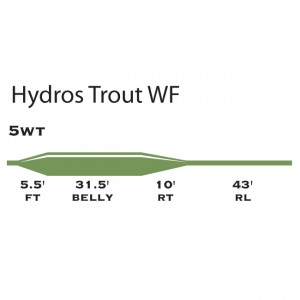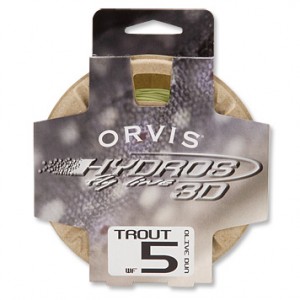The Orvis Hydros Trout flylines have been out for just over a year now, so we’ve had plenty of time to test them. In fact, I have one that has seen about 120 days or so, and is still going strong. Tasmania is our main testing ground, complete with the winds of the Roaring-Forties, coupled with smooth waters and finicky brown trout. This can be a tough combination to cater for: the flyline taper needs to be aggressive enough to deliver into strong winds, but delicate enough to provide control over a mix of distances, from 10 feet to 50.
There’s three elements to the Hydros line that have made it a Used and Approved bit of fly fishing gear: the taper, the weight, and the coating.
The taper is what I’d describe as a ‘medium’ weight-forward taper: that is, a taper that is neither aggressive, nor delicate. Instead, it is the ideal blend of both, with a 5.5’ front taper, 31.5’ belly, and a 10’ rear taper (see image). To put this in perspective, one of the other top selling lines at the moment has a 5’ front taper, a 23’ belly, and a 19’ rear taper. What’s the difference you ask? From my experience, the Hydros taper with its longer belly (the weight spread further) provides far more control over a greater range of distances, which is important when you are throwing tight and fast loops into, and across, strong winds.
The ‘weight’ of the Hydros line is the second winning element. The given weight of a flyline relates to the physical weight of the first 30’ of line, and is benchmarked to a standard. Interestingly though, over the past few years most line manufacturers have begun to ‘overweight’ their lines: designated 5 weight lines are often 5 ½ to 5 ¾ weight lines these days. The premise behind this shift has been the thought that a slightly heavier line will load modern, fast-actioned fly rods better for the average caster. To some degree this is true, but an over-weighted rod and line can also lead to worse-tailing loops and less control. So for me, a line that is true-to-weight is important, and on that account, the Hydros is spot-on for me.
The final elements in the winning formula of the Hydros Trout lines are the Orvis coatings. The outer coatings of these flylines are relentlessly tough, slick, and float as good as any line I’ve ever used. A tough coating is good when our lines end up covered in mud on the bottom of the raft, or sandwiched between a wading boot and a Western Lakes rock, day-in day-out. The ‘slickness’ is important, ensuring that the line keeps zinging out the guides, and self-cleans to some degree. Flotation is the final ingredient to a good floating line: the tip needs to float as high as possible, as a sunken-tip and leader-butt will create drag on the presentation, and noisy / messy pickups. The Orvis Hydros Trout lines are my favourite for marrying durability, slickness and flotation together for the best flyline available.


